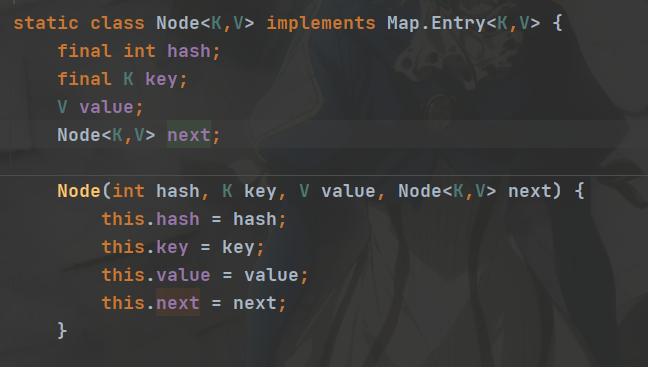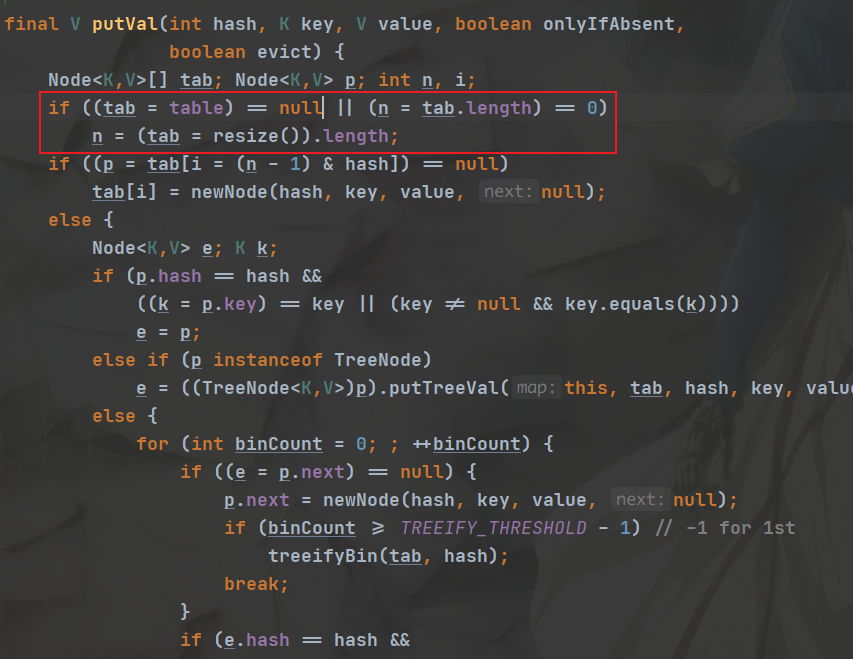title: 【学习之路】HashMap源码分析
draft: true
tags:
- 学习之路
- Java
- 集合
categories: - JavaSE
- 集合
description: HashMap源码分析
abbrlink: ‘16860e4’
date: 2021-04-01 14:16:50
cover: https://cdn.jsdelivr.net/gh/CodeZixuan/Blog_Images/HashMap/bg.jpg
JDK7底层实现
- 在实列化以后,底层创建了一个长度是16的一维数组Entry[] table

- 当调用put()方法之后首先会调用当前key所在类的hashCode()方法计算key的hash值,通过计算以后,得到在Entry数组中的存放位置。
如果此位置的上的数据为空,此时key-value添加成功
如果此位置上的数据不为空(就意味着当前位置上存在一个或多个数据(以链表的形式存在)),比较key和已存在的一个或多个数据
如果key的hash值与已经存在的数据的hash值都不相同,此时key-value添加成功
如果key的hash值和已存在的某个数据hash值相同则调用当前key所在类的equals()方法继续比较
如果equals()返回false:此时key-value添加成功如果equals()返回true:当前添加的key的value会替换已经添加的value
JDK8底层实现
- new HashMap():底层没有创建一个长度为16的数组

- jdk 8底层的数组是:Node[],而非Entry[]

- 首次调用put()方法时候底层才会创建一个长度为16的数组


- JDK7中的底层结构只有数组+链表。JDK8中底层结构:数组+链表+红黑树
当数组的某一个索引位置上的元素以链表的形式存在的个数大于8 且当前数组的长度 大于64时,此时索引位置上的所有数据修改为使用红黑树存储
源码解析
public V put(K key, V value) {// 先调用hash方法计算出当前key的hash值return putVal(hash(key), key, value, false, true);}
hash值的计算过程
static final int hash(Object key) {int h;/*判断当前key是否为空如果key为空那么hash值直接返回0,如果不为空,调用当前key类型的hashCode方法(前提是当前类重写了hashCode)计算出来的hash值再进行无符号右移16后,再进行异或运算减少hash碰撞*/return (key == null) ? 0 : (h = key.hashCode()) ^ (h >>> 16);}
putVal():key值的存储过程
final V putVal(int hash, K key, V value, boolean onlyIfAbsent,boolean evict) {Node<K,V>[] tab; Node<K,V> p; int n, i;// 初始化操作,判断当前table,数组是否为空或长度为0如果为true会使用resize()方法进行扩容if ((tab = table) == null || (n = tab.length) == 0)n = (tab = resize()).length;// 判断当前数据存储所在位置,如果当前位置为空那么直接进行存储if ((p = tab[i = (n - 1) & hash]) == null)tab[i] = newNode(hash, key, value, null);else {Node<K,V> e; K k;/*如果当前存储位置不为空,先判断当前需要存入key的hash值和当前位置已经存储key的hash值进行比较如果两个hash值不相同if语句直接结束如果两个hash值相同那么先判断已经存入的key和需要存入的key两个key地址是否相同如果不相同就判断当前key是否为不为空,并且调用需要存入key的equals方法将已经存入key作为参数传入进行比较,如果都为true,那么就代表当前key相同,将已经存入的key地址保存*/if (p.hash == hash &&((k = p.key) == key || (key != null && key.equals(k))))e = p;// 如果上面的if条件不满足先判断当前p的对象是否为红黑树else if (p instanceof TreeNode)e = ((TreeNode<K,V>)p).putTreeVal(this, tab, hash, key, value);else {// 判断当前位置下是否有更多链表元素for (int binCount = 0; ; ++binCount) {// 如果p的next为空代表下面没有更多的元素,将需要存入的元素直接链接到已经存在元素的末尾if ((e = p.next) == null) {p.next = newNode(hash, key, value, null);// 判断当前链表是否大于等于8,如果是,那么就会进入方法让当前链表变为红黑树if (binCount >= TREEIFY_THRESHOLD - 1) // -1 for 1sttreeifyBin(tab, hash);break;}// 用来判断已经存入位置的下一个链表的hash值与equals()是否相同if (e.hash == hash &&((k = e.key) == key || (key != null && key.equals(k))))break;p = e;}}/*判断e是否不为空,进入当前if代表需要存入的key值已经存在,接下来会替换已经存入key的value*/if (e != null) { // existing mapping for keyV oldValue = e.value;if (!onlyIfAbsent || oldValue == null)e.value = value;afterNodeAccess(e);return oldValue;}}++modCount;if (++size > threshold)resize();afterNodeInsertion(evict);return null;}
一般为第一次添加数据时初始化过程,和红黑树形成后长度不足
final Node<K,V>[] resize() {Node<K,V>[] oldTab = table;// 如果是第一次添加数据table值是null,先进性三目运算,把0赋给oldCapint oldCap = (oldTab == null) ? 0 : oldTab.length;// 如果是第一次添加数据也没有临界值,临界值是0int oldThr = threshold;int newCap, newThr = 0;// 第一次添加数据oldCap是0所以这个if不会进入if (oldCap > 0) {if (oldCap >= MAXIMUM_CAPACITY) {threshold = Integer.MAX_VALUE;return oldTab;}else if ((newCap = oldCap << 1) < MAXIMUM_CAPACITY &&oldCap >= DEFAULT_INITIAL_CAPACITY)newThr = oldThr << 1; // double threshold}// 第一次添加数据临界值也是0,if也不会进入else if (oldThr > 0) // initial capacity was placed in thresholdnewCap = oldThr;else { // zero initial threshold signifies using defaults// 将DEFAULT_INITIAL_CAPACITY值给newCap,初始容量16newCap = DEFAULT_INITIAL_CAPACITY;// DEFAULT_LOAD_FACTOR加载因子为0.75 * 初始容量 16,newThr为12newThr = (int)(DEFAULT_LOAD_FACTOR * DEFAULT_INITIAL_CAPACITY);}// 判断临界点是否为0if (newThr == 0) {float ft = (float)newCap * loadFactor;newThr = (newCap < MAXIMUM_CAPACITY && ft < (float)MAXIMUM_CAPACITY ?(int)ft : Integer.MAX_VALUE);}// 临界值赋值threshold = newThr;@SuppressWarnings({"rawtypes","unchecked"})// Node数组长度newCap第一次存入数据长度为16Node<K,V>[] newTab = (Node<K,V>[])new Node[newCap];// 将数组对象给tabletable = newTab;if (oldTab != null) {for (int j = 0; j < oldCap; ++j) {Node<K,V> e;if ((e = oldTab[j]) != null) {oldTab[j] = null;if (e.next == null)newTab[e.hash & (newCap - 1)] = e;else if (e instanceof TreeNode)((TreeNode<K,V>)e).split(this, newTab, j, oldCap);else { // preserve orderNode<K,V> loHead = null, loTail = null;Node<K,V> hiHead = null, hiTail = null;Node<K,V> next;do {next = e.next;if ((e.hash & oldCap) == 0) {if (loTail == null)loHead = e;elseloTail.next = e;loTail = e;}else {if (hiTail == null)hiHead = e;elsehiTail.next = e;hiTail = e;}} while ((e = next) != null);if (loTail != null) {loTail.next = null;newTab[j] = loHead;}if (hiTail != null) {hiTail.next = null;newTab[j + oldCap] = hiHead;}}}}}return newTab;}
红黑树创建过程
final void treeifyBin(Node<K,V>[] tab, int hash) {int n, index; Node<K,V> e;// 首先判断传入的当前数组是否为空,再判断当前数组长度是否大于64(MIN_TREEIFY_CAPACITY为64),// 两个中有一个不满足就去扩容if (tab == null || (n = tab.length) < MIN_TREEIFY_CAPACITY)resize();else if ((e = tab[index = (n - 1) & hash]) != null) {TreeNode<K,V> hd = null, tl = null;do {TreeNode<K,V> p = replacementTreeNode(e, null);if (tl == null)hd = p;else {p.prev = tl;tl.next = p;}tl = p;} while ((e = e.next) != null);if ((tab[index] = hd) != null)hd.treeify(tab);}}
HashMap属性介绍
// HashMap默认容量16static final int DEFAULT_INITIAL_CAPACITY = 1 << 4;// HashMap最大支持容量static final int MAXIMUM_CAPACITY = 1 << 30;// HashMap默认加载因子static final float DEFAULT_LOAD_FACTOR = 0.75f;// HashMap中链表最大长度默认值,大于该长度,转化为红黑树static final int TREEIFY_THRESHOLD = 8;// HashMap中红黑树存储小于该值那么转化为链表static final int UNTREEIFY_THRESHOLD = 6;// HashMap转化红黑树需要的数组长度,当数组长度大于该值并且链表长度大于8转化为红黑树static final int MIN_TREEIFY_CAPACITY = 64;// 存储元素的的数组transient Node<K,V>[] table;// 数组中HashMap键值对的数量transient int size;// 扩容的临界值,计算方式为 容量*填充因子int threshold;// 填充因子final float loadFactor;

